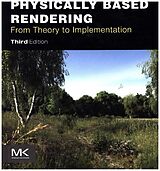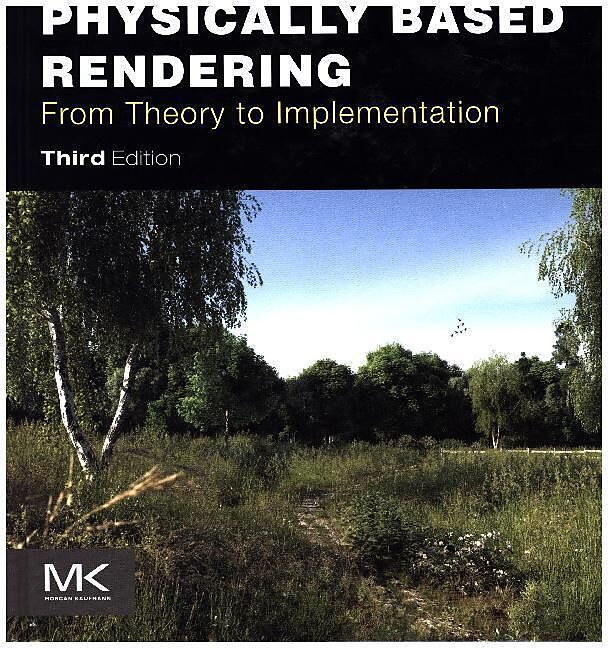Physically Based Rendering
Einband:
Fester Einband
EAN:
9780128006450
Untertitel:
From Theory To Implementation
Autor:
Pharr Matt, Jakob Wenzel, Humphreys Greg
Herausgeber:
Elsevier LTD
Auflage:
3. Auflage
Anzahl Seiten:
1266
Erscheinungsdatum:
21.11.2016
ISBN:
978-0-12-800645-0
Informationen zum Autor Matt Pharr is a Software Engineer at Google. He previously co-founded Neoptica, which was acquired by Intel, and co-founded Exluna, which was acquired by NVIDIA. He has a B.S. degree from Yale and a Ph.D. from the Stanford Graphics Lab, where he worked under the supervision of Pat Hanrahan. Wenzel Jakob is an assistant professor at EPFL's School of Computer and Communication Sciences. His research interests revolve around material appearance modeling, rendering algorithms, and the high-dimensional geometry of light paths. Wenzel obtained his Ph.D. at Cornell University under the supervision of Steve Marschner, after which he joined ETH Zürich for postdoctoral studies under the supervision of Olga Sorkine Hornung. Wenzel is also the lead developer of the Mitsuba renderer, a research-oriented rendering system. Greg Humphreys is Director of Engineering at FanDuel, having previously worked on the Chrome graphics team at Google and the OptiX GPU raytracing engine at NVIDIA. Before that, he was a professor of Computer Science at the University of Virginia, where he conducted research in both high performance and physically based computer graphics, as well as computer architecture and visualization. Greg has a B.S.E. degree from Princeton, and a Ph.D. in Computer Science from Stanford under the supervision of Pat Hanrahan. When he's not tracing rays, Greg can usually be found playing tournament bridge. Klappentext Physically Based Rendering: From Theory to Implementation, Third Edition, describes both the mathematical theory behind a modern photorealistic rendering system and its practical implementation. Through a method known as 'literate programming', the authors combine human-readable documentation and source code into a single reference that is specifically designed to aid comprehension. The result is a stunning achievement in graphics education. . Through the ideas and software in this book, users will learn to design and employ a fully-featured rendering system for creating stunning imagery. This completely updated and revised edition includes new coverage on ray-tracing hair and curves primitives, numerical precision issues with ray tracing, LBVHs, realistic camera models, the measurement equation, and much more. It is a must-have, full color resource on physically-based rendering. Inhaltsverzeichnis 1. Introduction 2. Geometry and Transformations 3. Shapes 4. Primitives and Intersection Acceleration 5. Color and Radiometry 6. Camera Models 7. Sampling Reconstruction 8. Reflection Models 9. Materials 10. Texture 11. Volume Scattering 12. Light Sources 13. Monte Carlo Integration 14. Light Transport I: Surface Reflection 15. Light Transport II: Volume Rendering 16. Light Transport III: Bidirectional Methods 17: Retrospective and the Future...
Autorentext
Matt Pharr is a Software Engineer at Google. He previously co-founded Neoptica, which was acquired by Intel, and co-founded Exluna, which was acquired by NVIDIA. He has a B.S. degree from Yale and a Ph.D. from the Stanford Graphics Lab, where he worked under the supervision of Pat Hanrahan.Wenzel Jakob is an assistant professor at EPFL's School of Computer and Communication Sciences. His research interests revolve around material appearance modeling, rendering algorithms, and the high-dimensional geometry of light paths. Wenzel obtained his Ph.D. at Cornell University under the supervision of Steve Marschner, after which he joined ETH Zürich for postdoctoral studies under the supervision of Olga Sorkine Hornung. Wenzel is also the lead developer of the Mitsuba renderer, a research-oriented rendering system.Greg Humphreys is Director of Engineering at FanDuel, having previously worked on the Chrome graphics team at Google and the OptiX GPU raytracing engine at NVIDIA. Before that, he was a professor of Computer Science at the University of Virginia, where he conducted research in both high performance and physically based computer graphics, as well as computer architecture and visualization. Greg has a B.S.E. degree from Princeton, and a Ph.D. in Computer Science from Stanford under the supervision of Pat Hanrahan. When he's not tracing rays, Greg can usually be found playing tournament bridge.
Klappentext
Physically Based Rendering: From Theory to Implementation, Third Edition, describes both the mathematical theory behind a modern photorealistic rendering system and its practical implementation. Through a method known as 'literate programming', the authors combine human-readable documentation and source code into a single reference that is specifically designed to aid comprehension. The result is a stunning achievement in graphics education. . Through the ideas and software in this book, users will learn to design and employ a fully-featured rendering system for creating stunning imagery. This completely updated and revised edition includes new coverage on ray-tracing hair and curves primitives, numerical precision issues with ray tracing, LBVHs, realistic camera models, the measurement equation, and much more. It is a must-have, full color resource on physically-based rendering.
Zusammenfassung
"Physically Based Rendering is a terrific book. It covers all the marvelous math, fascinating physics, practical software engineering, and clever tricks that are necessary to write a state-of-the-art photorealistic renderer. All of these topics are dealt with in a clear and pedagogical manner without omitting the all-important practical details."
--Per Christensen, Senior Software Developer, RenderMan Products, Pixar Animation Studios
"This book has deservedly won an Academy Award. I believe it should also be nominated for a Pulitzer Prize."
--Donald Knuth
Inhalt
1. Introduction
2. Geometry and Transformations
3. Shapes
4. Primitives and Intersection Acceleration
5. Color and Radiometry
6. Camera Models
7. Sampling Reconstruction
8. Reflection Models
9. Materials
10. Texture
11. Volume Scattering
12. Light Sources
13. Monte Carlo Integration
14. Light Transport I: Surface Reflection
15. Light Transport II: Volume Rendering
16. Light Transport III: Bidirectional Methods
17: Retrospective and the Future

Leider konnten wir für diesen Artikel keine Preise ermitteln ...
billigbuch.ch sucht jetzt für Sie die besten Angebote ...
Die aktuellen Verkaufspreise von 6 Onlineshops werden in Realtime abgefragt.
Sie können das gewünschte Produkt anschliessend direkt beim Anbieter Ihrer Wahl bestellen.
Loading...
Die aktuellen Verkaufspreise von 6 Onlineshops werden in Realtime abgefragt.
Sie können das gewünschte Produkt anschliessend direkt beim Anbieter Ihrer Wahl bestellen.
| # | Onlineshop | Preis CHF | Versand CHF | Total CHF | ||
|---|---|---|---|---|---|---|
| 1 | Seller | 0.00 | 0.00 | 0.00 |
